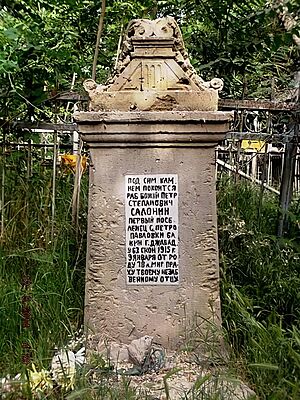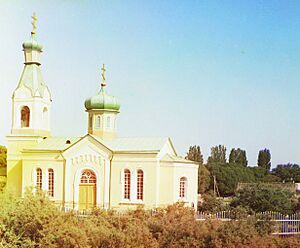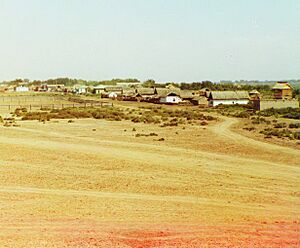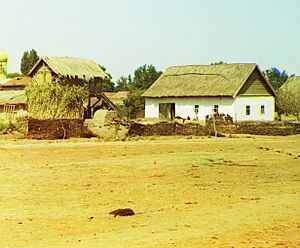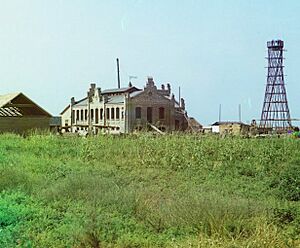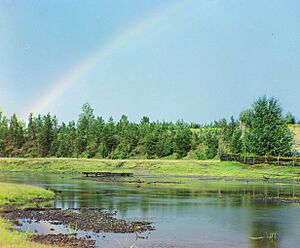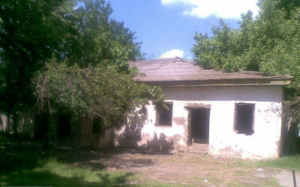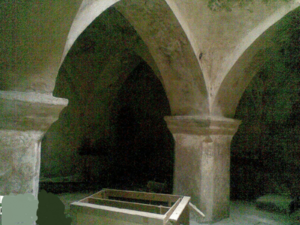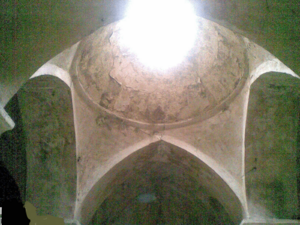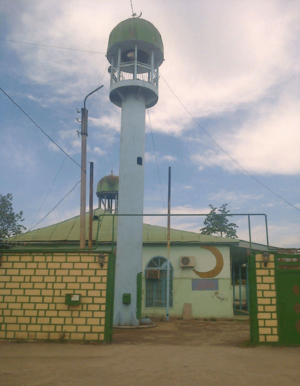Sabirabad (city) facts for kids
Quick facts for kids
Sabirabad
|
|
|---|---|
 |
|
| Country | |
| District | Sabirabad |
| Established date | 1888 |
| Area | |
| • Total | 12,46 km2 (481 sq mi) |
| Elevation | -12 m (−39.4 ft) |
| Population
(2018)
|
|
| • Total | 30,612 |
| • Density | 2,460/km2 (6,400/sq mi) |
| • Population Rank in Azerbaijan | 21st |
| Time zone | UTC+4 (AZT) |
| Area code(s) | +994 21 |
| Vehicle registration | 54 AZ |
| Website | sabirabad-ih.gov.az |
Sabirabad is an important city in Azerbaijan. It is the main city of the Sabirabad District. The city was once known by other names like Galagayin and Petropavlovka. It was later renamed to honor a famous poet, Mirza Alakbar Sabir. Sabirabad is located on the right bank of the Kura River. Close to the city, the Araz River joins the Kura River. In 1935, Sabirabad became a city with its own local government.
Contents
History of Sabirabad
After the Gulistan Peace Treaty in 1813, parts of Azerbaijan, including the Mughan Plain, came under Russian control. In 1868, a new area called Javad Uyezd was created. Later, many Ukrainian farmers moved to Javad. By 1888, this settlement was known as Petropavlovka.
Petropavlovka was part of the Javad area within the Baku Governorate. In 1901, there were 87 farms, and by 1907, there were 13 Russian villages nearby. By 1913, the area had a cotton-cleaning factory and two mills. On May 1, 1920, after the Red Army invasion of Azerbaijan, Petropavlovsk became a local government center. From 1921 to 1929, it was the Petropavlovsk district of Djevatskoye Uyezd. In 1929, it was renamed the Petropavlovsk district of Mugan. On August 8, 1930, Petropavlovsk became an independent region. Then, on October 7, 1931, it was officially renamed Sabirabad. This was in honor of the Azerbaijani poet Mirza Alakbar Sabir, who is known for his satirical writings.
How Sabirabad City Was Formed
The history of Sabirabad city really began in 1868. There was a weekly market held on Thursdays between the old villages of Sugovushan and Galagain, near the Kura and Araz rivers. The first two-story building and an Orthodox church were built here. These were meant for a new city called Javad.
However, the plan to rebuild Javad city was later stopped. In 1887, 26 Ukrainian families moved to this settlement, and it was named Petropavlovsk. By 1901, there were 87 farms here. The village grew in the early 1900s. On August 8, 1930, Petropavlovsk became the center of its district. It was renamed Sabirabad on October 2, 1931. The settlement officially became a city on December 4, 1959.
In the late 1800s, two noble brothers, Peter and Paul, were sent by the Russian Tsar to grow cotton here. They started a cotton plant and a shipyard near where the Kura and Araz rivers met. At that time, the Araz River was closer to the Kura. Cotton harvested here was sent by ships down the Kura River to the Caspian Sea, then up the Volga River to Russian cities. Farmers in nearby villages were encouraged to grow cotton.
Many skilled workers and their families from Russia came to work at the plant and shipyard. Homes, hospitals, and other public buildings were built for them. This led to the formation of a Russian village in what is now Sabirabad. After the 1828 Turkmenchay treaty, the Russian Empire wanted to secure its southern borders. They settled people from Russia and Ukraine along the border to protect it. In the Sabirabad area, villages like Krasnoselsk, Pokrovka, Novodon, and others were built. The current Sabir canal was also dug to bring water from the Araz River for farming in these new villages.
After an earthquake in Shamakhi in the early 1900s, many people from Shamakhi moved here. They built a neighborhood, a cemetery, and a mosque.
Later, people from Iran and Meskhetian Turks also settled here. This mix of people helped form the diverse population of Sabirabad. The Tsar government also asked the Vagen brothers to build a factory to process raw cotton. They brought experts from Germany, and the plant started operating in 1906.
The Kura and Araz rivers often flooded the city, causing damage. To help with this, the USSR government created special brigades. As technology improved, auto repair and tractor repair stations were also built. Russian neighborhoods grew around these offices.
Geography and Climate
Sabirabad's land is mostly made of sediments. The climate is mild and warm, like a semi-desert or dry desert. The soil is mainly gray-grass. You'll find many semi-desert plants here, and some desert plants in certain areas. In salty soils, you might see plants like halophytes, which form small hills. Other plants include wormwood and various annual grasses. Large areas of the semi-desert are used to grow cotton and grain.
Population
As of January 1, 2018, the population of Sabirabad was 30,612 people.
Culture and Landmarks
Sabirabad has some interesting old buildings.
- Old Hamam: This old bathhouse, built in 1901, is on Fizuli Street. It's a protected historical building and needs some repairs.
- Shamakhi Mosque: This mosque was built in 1903 by people from Shamakhi who moved to Sabirabad after an earthquake in their hometown.
Education
Sabirabad has 8 secondary schools. The city also has a college and a vocational high school.
State Social and Economic College
The Sabirabad State Social and Economic College was created from the Sabirabad Agricultural Technical School. It helps improve vocational education. The college has 40 teachers and 93 staff members. Currently, 570 students are studying there in various fields, including:
- Physical education
- Vocational training
- Road traffic organization
- Veterinary studies
- Accounting
- Financial business
- Banking
- Family and home education
- Organization of municipalities
- Archive work and clerical duties
- Library and information support
Sabirabad Vocational High School
The Sabirabad Vocational High School started in 1974 as a secondary vocational school. In 1996, it became a high school. It is located on a 7-hectare area and has one study building and two dormitories. There are 240 students at the school. They can choose from 8 special training groups, such as:
- Tractor-machinist and repairer
- Fitter for agricultural machinery
- Animal artificial insemination techniques
- Hand power welders
- Computer master
- Cotton grower
The school has 24 teachers and 14 production trainers. There are also 19 special workshops for vocational training.
Sports
The Sabirabad District Youth and Sports Department has been active since 1994. It brings together all sports organizations in the area. The Sabirabad Olympic Sports Complex opened in 2008. This complex has greatly helped sports in the district. It offers training in:
- Freestyle wrestling
- Boxing
- Mini football
- Karate
- Simulator training
- Ping-pong (table tennis)
- Swimming
- Athletics
You can find more information about the department's activities on its official website.
Football
Sabirabad has a football pitch with an artificial surface. Another one is being built. There are three children's football teams. The futsal team plays in the national championship.
Wrestling
Wrestling is very popular here. About 500 teenagers and young people are involved in freestyle wrestling. Some wrestlers from Sabirabad, like Seyfulla Mehdiyev, Vugar Kerimov, and Shahin Abbasov, have become national champions.
Boxing
Boxing has been around for two years, with about 50 teenagers and young people participating.
Karate
Karate players from Sabirabad have won many competitions and participated in national championships.
Athletics
Athletics is popular in secondary schools. Rufat Mehdiyev is a national champion in this sport.
Table tennis and swimming are also popular sports in the district.
Notable People from Sabirabad
- Lutfiyar Imanov — A famous Azerbaijani Soviet singer.
- Elvin Aliyev — A football player.
Images for kids
See also
 In Spanish: Sabirabad para niños
In Spanish: Sabirabad para niños



